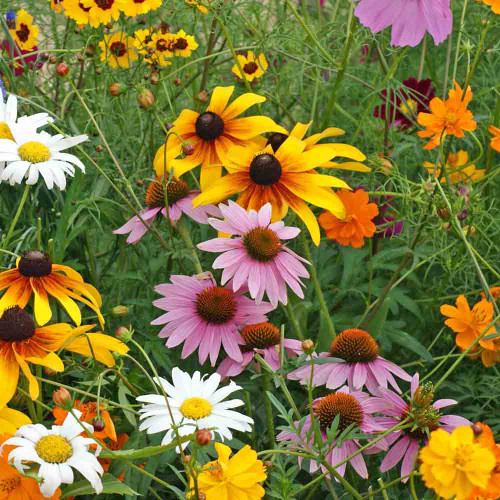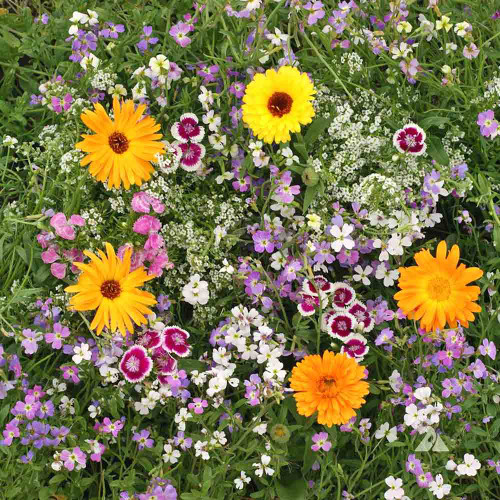Description
China Aster Mix - Gardener's Delight and Pollinator's Paradise
When the summer heat has you dreaming of cool drinks and shady afternoons, the China Aster Mix makes its grand entrance, a lively and colorful reminder that the garden's story is far from over. In a delightful array of reds, pinks, purples, and whites, these old-fashioned, single-flowered asters bring a refreshing touch to the late summer garden. They sway gently in the breeze, a vivid backdrop to your other blooms, attracting pollinators and your admiring gaze. A favorite of florists for their exceptional vase life, they also make stunning cut flowers, bringing the garden's beauty indoors.
Details
The botanical name, Callistephus chinensis, translates to "beautiful Chinese crown," a fitting tribute to their regal blooms. While often called asters, their star-like flowers connect them to the old English name "starworts," and the Latin word "aster" simply means "star."
Native to China and Korea, they belong to the Asteraceae family, shared with sunflowers, daisies, and chrysanthemums. These are the classic cut-flower asters, the kind you find gracing florist shops with upright blooms on strong, straight stems. Their oval leaves, with gently toothed edges, grow alternately along the stem. They reach 12 to 36 inches tall and provide ample stems for your bouquets. They thrive in USDA Hardiness Zones 2 through 11 and are a valuable food source for bees, butterflies, and other beneficial insects. Our Single Mix features single blooms, ranging from 3 to 5 inches in diameter, in shades of purple, deep rose, pink, violet, and white, providing a burst of color from mid-summer through early fall, precisely when many other annuals are beginning to fade.
History
China asters have a long and rich history, stretching back 2,000 years in their native China. These beautiful flowers have graced gardens and homes for millennia! Their journey westward began in 1728, when Father Pierre Nicolas d'Incarville, a French Jesuit missionary and botanist, sent seeds from China to Paris. This marked the introduction of the China aster to Europe, sparking a wave of horticultural interest. Initially grown in European botanical gardens like Paris's Jardin des Plantes, it attracted attention for its vibrant, daisy-like blooms and adaptability as an annual. Just a few years later, in 1731, Philip Miller, a prominent botanist, grew them in England, further establishing their place in European gardens. Throughout the 18th century, these showy annuals rapidly gained popularity, becoming a beloved addition to European gardens. They were so beloved that in the late 1700s, potted China asters were sold by the thousands in France, where they were affectionately known as "Reine Marguerites" (Queen Daisies).
The appeal of the China aster quickly crossed the Atlantic, and by 1737, John Custis of Williamsburg, Virginia, was growing them in American gardens. The passion for these flowers continued to grow, and by 1804, Bernard McMahon of Philadelphia, a noted horticulturist, offered eleven Aster chinensis cultivars in his seed catalog. This impressive selection included double and quilled forms, showcasing the early development of diverse flower shapes. From humble beginnings—the original species featuring single flowers in serene shades of blue, violet, or white—centuries of dedicated breeding have yielded the dazzling array of colors and flower forms we know and love today.
Uses
China asters are prized for their long-lasting beauty in bouquets and arrangements, often lasting 7 to 10 days or more in a vase. Beyond their role as cut flowers, they play a vital role in the garden, attracting a variety of pollinators, including bees, butterflies, and other beneficial insects. They are particularly attractive to long-tongued bees, who can reach the nectar deep within the flower. Butterflies, drawn to the vibrant colors and abundant nectar, also frequent China asters. These charming blooms also welcome other beneficial insects to your garden, such as ladybugs, which help control garden pests. Plant them in beds, borders, cottage gardens, cutting gardens, or even containers to enjoy their vibrant display and the lively activity they bring.
Companion Planting
Companion planting can enhance the growth and health of your China asters, which can benefit other plants in your garden.
Consider pairing them with black-eyed Susans, coneflowers, sunflowers, zinnias, and garden phlox. These companions offer visual contrast or provide support for taller varieties. Asters can also improve the growth of many crops and attract beneficial insects that aid in pollination and pest control. For example, planting them near vegetables like lettuce, spinach, onions, garlic, and cole crops can attract hoverflies and predatory wasps. These beneficial insects then help control aphids and other common garden pests.
Avoid planting asters with shade-loving and moisture-loving plants.
Planting and Growing Tips
For the best results, start China aster seeds indoors 6 to 8 weeks before the last frost, sowing them on top of the soil mix and gently pressing them in. Maintain a soil temperature of 70 to 72°F for germination, which typically takes 10 to 20 days. China asters prefer full to partial sunlight. Pinch back young plants to encourage bushier growth and deadhead spent flowers to prolong blooming. Water at the base of the plant to prevent fungal diseases and ensure good air circulation. Successive sowings, every two weeks, will provide a continuous display of color throughout the late summer and fall.
A couple of key things to keep in mind with China Asters: they are day-length sensitive, meaning they start blooming after the summer solstice (around June 21st). Therefore, it's essential to transplant them into the garden after the last frost as soon as the soil is warm to the touch. Also, the seedlings are quite tender, so handle them with extra care during transplanting to minimize stress and ensure their healthy establishment in the garden.
Harvest Tips
Harvest China asters in the cool of the early morning or late evening using sharp, clean tools. Cut stems when the flowers are about halfway open. Remember that China asters are annuals, so each stem will bloom only once. After cutting, strip the leaves from the lower half of the stems and immediately place them in cool water with flower food. Recut the stems every few days and change the water to prolong their vase life.
Learn More
From the soil to the seed to the food you eat - we'll help you grow your best garden!























